Studio G7 continues the exhibition season with a new dialogue proposal between a historical artist from the gallery, founded in 1973 by Ginevra Grigolo and now led by the young Giulia Biafiore, and a new entry selected among the most talented emerging artists from the conceptual and non- figurative scene, which represents the main line of research of the gallery. The double show by Mariateresa Sartori (Venice, 1961) and Caterina Morigi (Ravenna, 1991) presents an unprecedented association between two artists from different generations who, through different languages and formalization procedures, discover in this comparison that they start from very similar assumptions for carrying out an interrogation of the intrinsic dynamics of matter aimed at bringing out the epistemological implications of its physical and chemical conformation.
Mariateresa Sartori focuses the works on display on the exploration of the most immaterial substance, namely the air considered in the different forms of breath, wind and exhalation. The poetics of the Venetian artist is centered on the artistic conceptualization of the human being’s tension towards a knowledge destined to be always incomplete because it is based on random bases and is expressed in procedures characterized by empirical automatisms in which the tools of painting are used as devices of detection of invisible forces in action. The works presented on this occasion sketch a sort of fragmentary domestic dimension, in which the rigorous formal conciseness of each element actually hides uncontrollable doubts and tensions. The Domestic drafs (Spifferi domestici) series (2021), for example, is made up of drawings that “photograph” the air currents present in the artist’s house without the need for her direct intervention. In the points of the rooms crossed by gusts, Sartori has in fact installed her artisan anemometer, that is a stick with a termination of thin wool threads dipped in linseed oil and black pigment, which according to the intensity and directions of the wind produces each I work by imprinting an unrepeatable trace on a white sheet. This rudimentary brush, free to move because it is attached to ropes, and the particular paper-stone used that does not offer any friction to the pigment, are tools that are highly sensitive to any change of air, at the origin of an infinite variety of visual configurations. If in this case the artist limited herself to preparing the device and letting it act in order to then consider the results, in Evidenzia del soffio (Highlight of the breath), 2022, her contribution appears more intimate, while continuing to be based on a precise predetermination of the process. In fact, a circular portion of transparent glue was previously applied to each sheet of this series, the function of which is to retain the pigment powder that Sartori places in a corner and then spread in the air through her natural exhalation. The three-dimensionality and internal spirals of these precious aggregates of pure color surrounded by imperceptible smudges become fascinating epiphanies of the creation of new worlds through the breath, in a sudden revelation of the poetic intent underlying this apparently ordinary action. The approach is instead more mental in Elenco dell’aria (List of the Air), 2022, a canvas composed of square modules made with the technique of blowing pigments on paper prepared with glue (this time through a special straw due to the large size of the canvas). Here the silver fusaggine powders were initially distributed on the lower edge of each square and their scattering at the moment of the breath makes visible a catalog of landscapes which are impossible to systematize and archive, whose juxtaposition on the canvas materializes a further setting, mysteriously immersive in its fragmentation. Do infinito (2022) is a sound work composed of recordings of C (another type of air emission) performed by opera singers in which the note is kept longer and longer. The idea of a mosaic of infinite “subjective objectivities” returns in an even more dematerialized form together with the tension of a yearning for an unattainable completeness in which the mechanical nature of the procedures is imbued with existential implications.
Caterina Morigi‘s investigation, on the other hand, focuses on the relationship between micro and macro of matter and on the exploration of new hybridization hypotheses between the natural and the artificial dimension with the aim of discovery and knowledge, which is based on the contemporary reworking of the concept of mimesis. The works on display reflect on the double meaning of the idea of a “crater”, intended both as a funnel-shaped cavity that constitutes the orifice of a volcano’s chimney and as a large-mouthed vase, often preciously decorated, in which the ancient Greeks and Romans prepared the mixture of wine and water that was served at banquets. Exploring the material consequences of the hybridization of these two meanings and the imperfect coincidence between the two identities, the artist conceived a series of sculptures in which form and substance are manipulated to make them as close as possible to the conceptual implications deriving from the collision of the two different suggestions. For this reason Morigi, whose creative process is mapped in a diary of projects, annotations and drawings exhibited in a video, creates interlocking ceramics taking inspiration from both meanings of crater, which are inscribed in a surprisingly complementary way in each sculptural object. Her cups are in fact made by mixing lava materials she collected on Etna with fresh clay still to be modeled, also black because it comes from a lava area, with the addition of iridescent shell fragments. The passion for stone, which in some of her previous projects resulted in a lenticular observation of its surface veins and in the search for similarities with the texture of human skin, here pushes her not to model clay directly with her hands, but to do it through a stone-tool that becomes a prosthesis and at the same time a matrix, since the surface consistency of the vessels derives from the repetition of the imprint of the rough stone in the material. During the cooking phase, the lava fragments melt, generating cavities and drips which by analogy recall the pearly shades of the inside of the shells, in turn present both in the form of inserts and as imprints. The consistency of the results despite the unpredictability of the process, which does not allow the artist to know the behavior in the firing phase of lava concretions of different composition and resistance, reinforce the idea underlying all of Morigi’s artistic production, that man and nature are part of the same system of relationships within which inexhaustible hypotheses of symbiosis can be identified, generated by the association of concepts based on their analogies at the level of form and substance. Here too, with a three-dimensional declination, the notion of mimesis and the intent to reproduce the real after its deconstruction allow the materials to make associations that, without the intervention of the artist, would be destined to remain latent. Morigi’s approach appears to be increasingly oriented towards translating into a poetic key methodologies shared by scientific experimentation, as it can be seen, for example, by the fact that the choice to include the shell in her visual research derives from a collaboration with a laboratory of the Rizzoli Orthopedic Institute in which the possibility of reconstructing human bones with this material, which has proved to be so compatible that it is able to trigger the natural regrowth of damaged bone, is studied.
Info:
Caterina Morigi | Mariateresa Sartori
curated by Laura Lamonea
29/04/2022 – 10/09/2022
Galleria Studio G7
Via Val D’Aposa 4A, Bologna
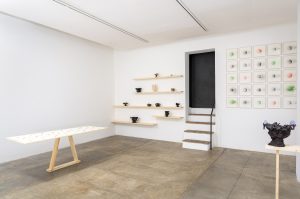 Caterina Morigi | Mariateresa Sartori, installation view at Studio G7, courtesy Studio G7, Bologna
Caterina Morigi | Mariateresa Sartori, installation view at Studio G7, courtesy Studio G7, Bologna
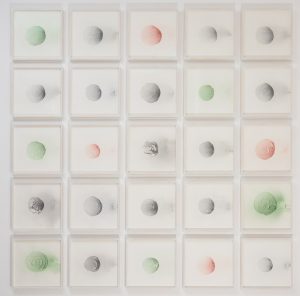 Mariateresa Sartori, Evidenza del soffio, 2022, air, silver fusage, pigments and glue on cotton paper, cm 30 x 30 each, courtesy Studio G7, Bologna
Mariateresa Sartori, Evidenza del soffio, 2022, air, silver fusage, pigments and glue on cotton paper, cm 30 x 30 each, courtesy Studio G7, Bologna
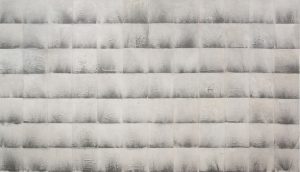 Mariateresa Sartori, Elenco dell’aria, 2022, air, silver fusage on canvas, cm 124 x 215, courtesy Studio G7, Bologna
Mariateresa Sartori, Elenco dell’aria, 2022, air, silver fusage on canvas, cm 124 x 215, courtesy Studio G7, Bologna
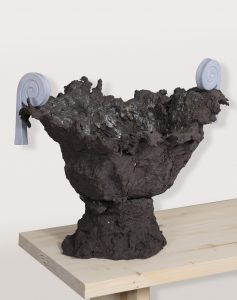 Caterina Morigi, Cratere, Faenza, 2022, semi-refractory earth and porcelain, variable dimensions, courtesy Studio G7, Bologna
Caterina Morigi, Cratere, Faenza, 2022, semi-refractory earth and porcelain, variable dimensions, courtesy Studio G7, Bologna
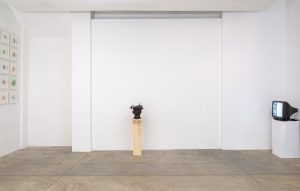 Caterina Morigi | Mariateresa Sartori, installation view at Studio G7, courtesy Studio G7, Bologna
Caterina Morigi | Mariateresa Sartori, installation view at Studio G7, courtesy Studio G7, Bologna
Graduated in art history at DAMS in Bologna, city where she continued to live and work, she specialized in Siena with Enrico Crispolti. Curious and attentive to the becoming of the contemporary, she believes in the power of art to make life more interesting and she loves to explore its latest trends through dialogue with artists, curators and gallery owners. She considers writing a form of reasoning and analysis that reconstructs the connection between the artist’s creative path and the surrounding context.






NO COMMENT